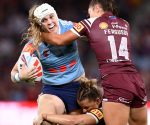They lost, they let Kane Cornes off the hook … but North might have finally worked out how to defend
If you’re a North Melbourne fan, you’re probably feeling rather conflicted about Thursday night’s loss to Essendon.
On the one hand, this was a second consecutive commendable performance in a row, a far cry from the horrors of Good Friday and the preceding weeks of footy that had launched North back into the dark days.
Captain Jy Simpkin had a sweet return of serve at Kane Cornes for his infamous round of criticism, lifting the Roos within inches – and a few Finnbar Maley set shot seconds – of victory with a commanding second half that featured several team-lifting plays, none better than his third quarter goal immediately followed by a shushing celebration aimed pointedly at his club’s most fervent critic.
Harry Sheezel was instrumental with his sharp ball use from half-back, not needing to play further afield to have an impact with his 32 disposals and game-high 591 metres gained.
And yet, for all that, it’s just another defeat, the seventh in eight games to start 2025. Another match fumbled in the crucial final minutes by poor kicking for goal and key mistakes at inopportune times. A chance to hand Cornes a clapback that would have rivalled throwing marshmallows at Kevin Sheedy for schadenfreude.
So if you’re struggling to balance the positive with the negatives, North fans, maybe this will tip you into the former camp: the Kangaroos, for the first time in years, appear to have figured out how to defend.
Holding a middle-of-the-road Essendon to just nine goals, while still being unable to conjure a winning score of their own, might not seem like much for the pessimists – but three goals in the final three quarters at Marvel Stadium, after giving up a triple-figure score in 11 of their past 14 matches, is a seismic improvement no matter who they were up against.
After a nightmare start that featured six Bombers goals in the first quarter, the North we saw was tenacious, well-discplined, and for the first time all year, seemed organised behind the ball. True, they were let off the hook at times by set shot misses, but gilt-edged chances from the Dons were still a rarity.
So what changed? Well, just about everything, especially after half time.
Up until then, the Bombers had controlled the corridor when moving forward: of their 22 inside 50s for the half, eight of them had come from right down the guts, so to speak.
From those eight inside 50s, North’s defence, already weak in terms of its personnel, was repeatedly given little chance of forcing a turnover or even a draw, with the likes of Nate Caddy, Peter Wright and Archie Perkins given ample leading lanes to work with, or otherwise needing to defend one on one, which regularly proved problematic.
Those eight inside 50s all contributed a score – four goals and four behinds, specifically, or nearly 60 per cent of the Bombers’ score.
It was a problem from literally the first bounce, when an under-pressure Harry Sheezel’s kick wobbled straight to Zach Merrett, who with time and space laced out the leading Perkins, the Roos’ defence scattered and the midfield given no time to get down and help out.
The Dons knew their enemy’s weakness, too: normally a high-handball, high-disposal team, they took that to the max in the first half, with more than half of their disposals – 99 to 97 – being handpasses and with a whopping 51 more disposals than North.
By half time, the Bombers had 39 disposals in what you’d consider to be the central corridor – that is, from 50m arc to 50m arc, within the width of the centre square. In short, the most dangerous position on the ground.
North Melbourne? Just 20.
It’s been a common theme to the Kangaroos’ struggles in recent times; with the Bombers holding firm in the clearances and contested possessions and denying North a win in those areas of supposed strength, their defensive frailties were able to be exposed.
But things could scarcely have been more different after half time.

Jade Gresham is tackled by Harry Sheezel. (Photo by Michael Willson/AFL Photos via Getty Images)
The Roos’ five third-quarter goals came largely from two sources, both of which are antithetical to their normal method of scoring: three from defensive half chains (two from as far back as defensive 50), and two from pressure forcing forward half turnovers.
This year, it’s been stoppage or bust for North, ranking third at scores from clearances, behind the mighty midfields of the Western Bulldogs and Gold Coast, but bottom four for scores from turnovers and 14th for scores from defensive half. Their defensive 50 to inside 50 success rate likewise sits in the bottom six.
There was a noticeable shift in attacking strategy after half time, with the Roos keener to change angles and fan out towards the wings when moving forward – though the corridor remained central to their plans.
Above all, the costly turnovers that repeatedly cruelled them in the first half disappeared with more unpredictable ball movement – where previously Bombers had been able to anticipate a straight-line direction and cut the play off early, as Ben McKay did late in the second term by jarring the ball free from Cameron Zurhaar and allowing a turnover that ended with a Perkins goal, now even if the play wasn’t perfect, it was typically getting to an intended target.
A perfect example is this play – first, a Luke Davies-Uniacke handball of the ultra-risky kind, of which similar led to four direct turnovers leading to shots at goal in the first half…

… this time goes to a sea of Kangaroo jumpers, allowing a clean breakaway with overlap runners – already, the play is promising.

After several handballs, it’s Jy Simpkin’s responsibility to kick – and instead of continuing up the corridor, where the Bombers have numbers and a missed pass would mean definite trouble, he fans wide towards Jacob Konstanty.

The kick misses the target, but Konstanty is in so much space that he’s able to gather the ball with ample time to spare, bound forward and find a leading Nick Larkey in the forward pocket.
Scoring in this manner is so much more sustainable than needing to do the lion’s share from clearances – the Roos found that out when their midfield got bullied against Carlton on Good Friday.
By the same token, the width the Bombers were so readily allowed in the first half vanished – they took just 16 marks in the third quarter, and with it, their ability to control the football vanished.
Defensively, the Roos this year have been guilty of defending too narrowly when the opposition is in possession, allowing teams to move the ball laterally and then quickly surge forward in vacant space without any capacity to cover it. It’s why they give up cricket scores most weeks.
After the first quarter, that became almost nonexistent for the Bombers. Take, say, this wave of possession that led to Nate Caddy’s early goal in the first quarter.

The Roos had stacked numbers around the ball when it was in the top right region of the picture, but when the Bombers surged forward they found it as easy as anything to transition the ball through the middle, with no North representation there to cut them off. Isaac Kako has four Dons riding shotgun down the corridor, with the Roos left scrambling to chase them.
Then take this, in the third quarter, from a more dangerous starting point and a more dangerous distributor in Zach Merrett…

This time, the Roos have bases covered in the corridor, with Jy Simpkin barking out instructions in centre frame for everyone to set up. Going centrally is not an option, and Caleb Daniel is close enough to Jade Gresham on the near side for any kick to him to need to go wide.
Ditto the other side – Merrett’s kick finds Will Setterfield, but it needs to hang in the air and go wide of his North opponent, Finn O’Sullivan, and by the time it reaches him the Roos have maintained their structure, cramped up the corridor, and forced him to go long down the line.
These are, quite literally, baby steps. We’re seeing the beginnings of a competent, AFL-standard defensive structure, and some competent, AFL-standard ball movement and scoring chains.
It was very nearly enough to topple a middle-of-the-road Bombers after sporting them a six-goal opening quarter.
And for the first time all season, it’s impossible to blame a Kangaroos defeat on the coach.










